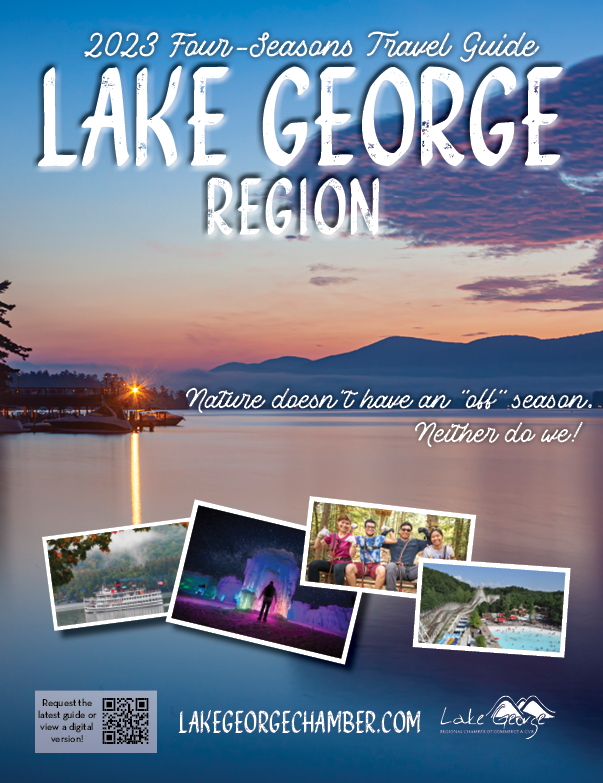Answer Key
Lake George Region Trivia Answers
How did you do in answering the trivia questions on page 55 of our 2023 Four-Seasons Travel Guide? See the answers below!
Q: A symbol of pure wilderness, this bird is known as the “Spirit of Northern Waters.” It’s a great swimmer but has trouble walking on land.?
A: The Loon
Q: Can you name the first Adirondack photographer whose work increased awareness and recognition of the Adirondacks, which brought tourists to the area?
A: Seneca Ray Stoddard (1843-1917) is best known for his photographs of the Adirondack Mountains, but he also was a cartographer, writer, poet, artist, traveler and lecturer. A sign painter by training, he turned to photography in his twenties. From his business base in Glens Falls he carried his cameras throughout the region, capturing the vistas and scenes of Adirondack life over a span of forty years. The 3000+ photographs in the Stoddard Collection document not only the Adirondack wilderness but also the human story of the region. Learn more here!
Q: How many gallons of sap does it take to produce one gallon of maple syrup?
BONUS: How old must a maple tree be before it is tapped for syrup making?
A: 40 gallons of sap. Maple trees should be at least 30+ years old before they are tapped.
Q: How many species of fish are located in the Lake George watershed?
A: There are 36 fish species in the Lake George watershed. Read more here!
Q: This 35-acre park maintains important open space at the southern end of Lake George and preserves major French & Indian War and Revolutionary War battle sites.
A: Lake George Battlefield Park. Learn more here!
Q: This famous novel is set in the Lake George region in the year 1757 during the French and Indian War.
A: The Last of the Mohicans by James Fennimore Cooper.
2022 Answer Key
Looking for the answers to the trivia questions on page 47 of our 2022 Four-Seasons Travel Guide? See the answers below to those questions and more!
Q: Which Adirondack philanthropist who was born into poverty in a foreign country went on to influence musical culture in America?
A: Marcella Sembrich — Visit The Sembrich in Bolton Landing, located on the beautiful shore of Lake George, and experience the Golden Age of Opera at The Sembrich Museum, the former teaching studio of internationally renowned Metropolitan Opera soprano Marcella Sembrich (1858-1935), where Juilliard and Curtis vocal students sought instruction from the acclaimed Sembrich. The Museum collection contains memorabilia of her distinguished career, with accolades from colleagues such as Brahms, Puccini, Rachmaninoff, and Verdi. Also featured are a working Victrola, her original Steinway piano, costumes, art, furniture, photographs, and tributes. Click here to learn more!
Q: Which U.S. President called Lake George "without comparison, the most beautiful water I ever saw; formed by a contour of mountains..."?
A: Thomas Jefferson
Q: This shy mammal builds an elaborate home, can climb trees, but prefers not to, and was given its name by the Algonquin Tribe of Native Americans. Can you guess what it is?
A: A Woodchuck! Originally named “Wuchak” by the Algonquin Tribe of Native Americans, it is the same as a Groundhog.
Q: Do you know where in the Adirondacks you can picnic, find an abandoned fort, statues of a Native American Warrior, Saint Isaac Jogues, William Johnson with his Mohawk Ally King Hendrick and a Memorial to Four Unknown Soldiers?
A: Lake George Battlefield Park
Q: Which mountain in Lake George offers the 100-mile view from its 2,030-foot summit? Hint: You can drive up!
A: Prospect Mountain
Q: One of the largest freshwater turtles found in North America is also New York's official state reptile. They eat plants, animals, birds, fish and dead organisms. Can you name it?
A: Snapping Turtle
Q: The namesake for the river which flows through the Adirondacks sailed to New York on his ship named The Half Moon in 1609. What is this famous traveler's name?
A: Henry Hudson
2021 Answer Key
Are you looking at a copy of the 2021 Four-Seasons Travel Guide? Below are the answers to the puzzels on page 47.
Word Search
 Word Scramble
Word Scramble
1. The Pinnacle
2. Pilot Knob
3. Sleeping Beauty
4. Shelving Rock Falls
5. Buck Mountain
2020 Answer Key
Are you looking at a copy of our 2020 Travel Guide? Below are the answers to those puzzels on Page 47 along with some interesting information about the Lake George region.
Word Search

Wondering why some of these famous names are in this word search?
And what does Andia-ta-roc-te mean?
Read on to find out!
Andia-ta-roc-te: The local Native American (Mohawk and Onondoga) name of Lake George, which means “lake that shuts itself in."
Lac Du St Sacrement: You might recognize this moniker as the largest ship in the Lake George Steamboat Company’s fleet, but it is also the first widely recognized name given to our lake by a European. In 1646, French-born missionary Father Isaac Jogues, gave this name to the 32-mile lake we love. Translated to English, it means "Lake of the Blessed Sacrament.” You can find a monument in honor of Saint Isaac Jogues in Battlefield Park in Lake George. It wasn’t until 1755 that Sir William Johnson — an Irish official in the British Empire — renamed the lake in honor of King George II. Johnson helped lead the British victory at the Battle of Lake George and the capture of Fort Nagara from the French during the French and Indian War. William Johnson also named Fort William Henry in honor of Prince William Henry, grandson of King George II.
James Fenimore Cooper: Cooper’s 1826 novel “The Last of the Mohicans” is set during the French & Indian War in the Lake George region. You can visit Cooper’s Cave on the Hudson River about 15 minutes south of Lake George to walk a viewing platform where you can see the caves described by Cooper in his novel and learn about the Mohicans.
Thomas Jefferson: When America’s 3rd President and author of the Declaration of Independence traveled to Lake George in 1791, he wrote that it was “without comparison the most beautiful water I ever saw.” He also said his trip, taken with James Madison, who would later be America’s 4th President, helped cure his headaches.
“Madison’s bilious attacks and Jefferson’s periodical headaches vanished in the days spent walking over Revolutionary War battlefields, scrutinizing botanical novelties, and fishing on Lake George. The whole, for Jefferson, was fortified by a scientific focus of national utility,” according to a post on Monticello.org.
Jefferson wrote these now-often quoted words in a letter to his daughter:
“Lake George is, without comparison, the most beautiful water I ever saw; formed by a contour of mountains into a basin thirty-five miles long, and from two to four miles broad, finely interspersed with islands, its water limpid as crystal and the mountain sides covered with rich groves of thuja, silver fir, white pine, aspen and paper birch down to the water edge, here and there precipices of rock to checker the scene and save it from monotony. An abundance of speckled trout, salmon trout, bass, and other fish with which it is stored, have added to our other amusements the sport of taking them …”
Georgia O’Keeffe: This groundbreaking American artist was a registered guest-artist in 1908 at Wiawaka, located on the eastern side of Lake George. From 1918 to 1934, she spent the better part of every year in Lake George at the family estate of her husband — photographer Alfred Stieglitz. Today Wiawaka hosts many programs for women, where women are welcome to stay overnight. You can also stay at Inn on The Hill, which is located on the site of Alfred Stieglitz and Georgia O’Keeffe’s farmhouse.
Word Scramble
1. Lake Trout
2. Salmon
3. Northern Pike
4. Yellow Perch
5. Bass





